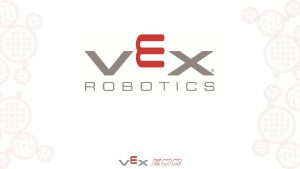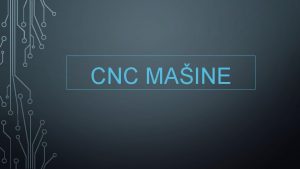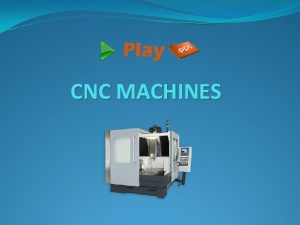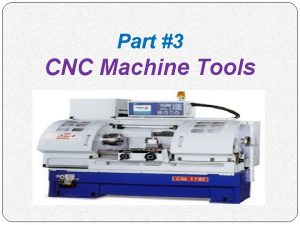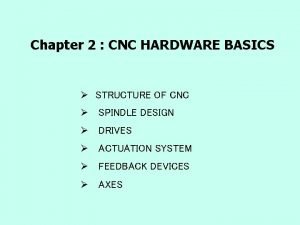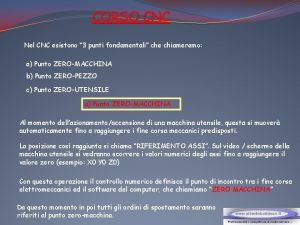Project Overview CNC Introduction Applying CNC Designing for












- Slides: 12


Project Overview § § § CNC Introduction Applying CNC Designing for CNC Manufacture Open Design for CNC Challenge Total VEX Robotics manufacture

LESSON 03

Lesson 03 Starter Learning objective: Apply knowledge of CAD to the design of suitable CNC parts, develop a range of specific functional components, and design a unique piece of VEX sheet metal equipment. Quick starter task Review your drawing and measurements from the previous lesson. Using these measurements, plan a new “simple” sheet metal VEX part that could be cut in a 2 D CNC machine (such as a plasma cutter). Draw the part out on paper, and label the critical part measurements (those that will ensure the part will connect to another VEX part) Key words: CAD, Library, heat processes, acrylic, MDF, profile, forming.

Designing for CNC Designing Sheet Metal Products in CAD Industry standard CAD packages, like Autodesk Inventor Professional, offer the specific CAD tools and design environment to design parts suited for CNC production. The design environment for creating sheet metal parts is different to a solid modelling environment, where outcomes would suit 3 D printing. The tools of extrusion and revolving are not useful to a process where thickness of the material is pre-defined, and cutting is only in 2 axis of movement on the same plane. However the opportunity to design sheet metal parts by previewing them in the “folded” end form, then flattening them into 2 D, is ideal for designing VEX parts.

Designing for CNC How are sheet metal parts different from solid model parts? Watch the following video, and consider how your task of modelling is going to be different from your previous experience of solid modelling. Make notes on the approach where appropriate.

Designing for CNC Sheet metal design environment Sketches in sheet metal use 2 D geometry to create features Processes from industry are replicated in the tool bar, such as punching, cutting and corner seams Modelling features in 3 D are very different to solid modelling Patterns, both rectangular and circular, and mirroring, are all features of solid and sheet metal modelling Specific to this design environment, sheet metal parts can be unfolded flat Material can be defined as a specific thickness (defaulted to 0. 5 mm)

Designing for CNC Modelling a simple steel part Modelling a simple part in the sheet metal modelling environment is different to a traditional approach in solid modelling. For example, to create this shape, you might start with a block, and remove the channel down the middle, or you might extrude thin C shape to create the body. After each of these you might then pattern the holes. In sheet metal, you begin by creating the bottom surface, before adding a flange feature on each long edge, which will create the small curve bend in the corner (which will occur when it is bent)

Designing for CNC Modelling task Watch the following video, and model the VEX C Channel part (15 hole). Note how to achieve the following steps in your notebooks: - modelling a perfect hole - patterning the hole to create the VEX style appearance - folding and forming parts Try to also identify: - when the software adds additional material to a bend to allow for the physical forming and deformation of the sheet steel

Designing for CNC Modelling task (cont) Referring to your starter sketch and the dimensions you added, your task is to now model this part in your software package. The part will also need to use common sheet metal tools and design methods. Extension If you finish this part, assemble it into a VEX clawbot assembly using the library of VEX clawbot files provided by your teacher.

Lesson 03 Plenary As a class, let us consider the following questions? A. How does Autodesk Inventor sheet metal environment modelling differ from solid modelling? B. What Clawbot parts are suitable to design in CAD and which parts are too complex to attempt? C. What key tools enhance the quality of sheet metal components? D. What is key to get right when designing sheet metal components?

Lesson 03 Summary Learning objective: Apply knowledge of CAD to the design of suitable CNC parts, develop a range of specific functional components, and design a unique piece of VEX sheet metal equipment. Today you have: § Applied Autodesk Inventor Sheet metal environment tools to a design task § Developed a range of specific product outcomes § Planned unique components in sheet metal to enhance an existing VEX Clawbot.
 Example of project overview
Example of project overview Sap project systems overview
Sap project systems overview Project management topics
Project management topics Multicullar
Multicullar Introduction product overview
Introduction product overview Introduction product overview
Introduction product overview Introduction product overview
Introduction product overview Introduction product overview
Introduction product overview Formuö
Formuö Typiska novell drag
Typiska novell drag Tack för att ni lyssnade bild
Tack för att ni lyssnade bild Vad står k.r.å.k.a.n för
Vad står k.r.å.k.a.n för Varför kallas perioden 1918-1939 för mellankrigstiden
Varför kallas perioden 1918-1939 för mellankrigstiden













